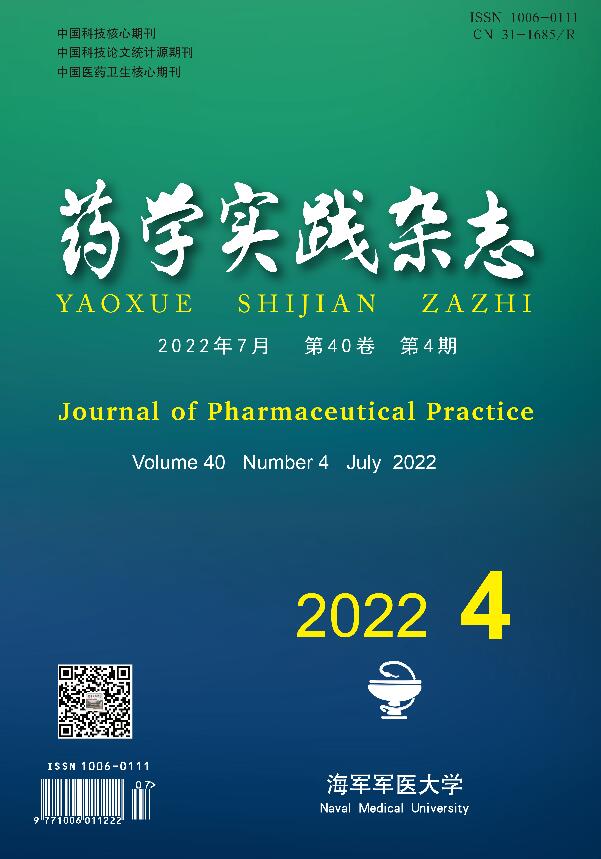-
浅部真菌病是军人的常见病和多发病,国内外对不同部队的多项调查研究表明,浅部真菌性皮肤病发病率在各类皮肤病中居于前列,尤其在南方、沿海地区和炎热季节[1-4],浅部真菌感染性皮肤病受到菌种、地域、机体免疫力、环境等多方面因素影响。目前抗真菌药物种类很多,主要有唑类、丙烯胺类、吗啉类、中草药等[5-6]。经调查发现,皮肤真菌感染治愈率不高,容易复发,患者用药依从性是影响疾病治愈率的重要因素[7-8]。低依从性在各类疾病治疗中普遍存在,会降低药物的治疗效果[9],因此,准确评估用药依从性对于制定有针对性的干预措施,提高患者的用药依从性十分重要。
学者Morisky于2008年发表了用药依从性量表(Morisky Medication Adherence Scale)[10],该量表为结构化的、包含8项量度的自我报告量表,最初用于高血压病的用药依从性分析,逐渐被广泛应用于其他疾病,特别是慢性疾病,如糖尿病、骨质疏松症等的用药依从性研究[11-12],国外较少有文献报道该量表对浅部真菌病用药依从性分析[13],国内未有关于Morisky量表对真菌感染疾病的应用。本研究基于Morisky量表进行适度修改,评估部队院校学员浅部真菌病用药依从性情况,了解该群体用药习惯、特点,为提高抗真菌药物治疗效果寻求解决方案。
-
①对某院校在校学员进行浅部真菌性皮肤病普查,包括手癣、足癣、体癣、股癣、头癣、花斑癣和甲癣,记录患病基本情况、既往病史、用药、生活习惯等情况,同时发放自制调查问卷,问卷由专家修订后制成电子问卷。由患有浅部真菌病病史且使用过抗真菌药物的学员现场填写问卷。②调查曾患有浅部真菌病学员用药依从性,采用8条目的Morisky量表,删除原量表中第五条“昨天您忘记服药了吗?”,因为该条目不适用于只需局部用药的浅部真菌病患者,而仍沿用其余7个条目作为学员浅部真菌病用药依从性评估的量表(见表1)。
条目 评分标准 1. 您是否有时忘记服用抗真菌药(内服和外用)? 否(1) 是(0) 2. 在用药治疗的2周内,是否有一天或几天您忘记用药? 否(1) 是(0) 3. 用药期间当您觉得症状加重时,您是否未咨询医生而自行减药或停药? 否(1) 是(0) 4. 当您外出时,您是否有时忘记随身携带药物? 否(1) 是(0) 5. 当您觉得自己的皮肤病已经得到控制时,您是否停止继续用药? 否(1) 是(0) 6. 您是否觉得要坚持治疗计划有困难? 否(1) 是(0) 7. 您觉得按时按量用药很难吗? 从不(1)、偶尔(0.75)、有时(0.5)、经常(0.25)、总是(0) -
评分标准:条目1~6题的答案均设计为是非式,选为“否”记1分,选为“是”记0分。条目7依据里克特(Likert)5级评分法,分为从不、偶尔、有时、经常、总是等五个选项,分别赋值为1、0.75、0.5、0.25和0分。总分为各项评分之和,评分<5分,表示依从性低,评分≥5分且<7分表示依从性中等,评分=7分表示依从性高。
-
采用SPSS 22.0软件进行统计学处理,通过内部一致性系数(Cronbach’s α)进行量表信度检验,通过KMO(Kaiser-Meyer-Olkin)检验、Bartlett’s球形检验、探索性因子分析进行量表结构效度检验,采用Spearman相关性分析,P<0.05为差异有统计学意义。信度检验参考标准:Cronbach’s α高于0.8,信度高;α介于0.7~0.8之间,信度较好; α介于0.6~0.7之间,信度可接受;α小于0.6,信度不佳。效度检验参考标准:KMO值高于0.8,效度好;KMO值介于0.7~0.8之间,效度较好;KMO值介于0.6~0.7,效度一般;KMO值小于0.6,效度较差。
-
经过体检普查及病史资料询问,调查学员中曾患浅部真菌病且使用抗真菌药物治疗的学员243例,回收问卷243份,有效问卷242份,均为男性(见表2)。问卷结果显示,90.08%学员使用局部药物治疗,8.68%学员使用局部与系统药物联合治疗。抗真菌药物中唑类药物使用率最高,如咪康唑、酮康唑,其次是丙烯胺类(特比萘芬)、中药洗剂、复方制剂(曲安奈德益康唑、复方十一烯酸锌曲安奈德)等。
人口学变量 变量值 人数(n) 百分比(%) 在读学历 本科 234 96.69 研究生 8 3.31 年龄(岁) 16~18 25 10.33 19~21 127 52.48 22~24 64 26.45 25~27 20 8.26 28~30 3 1.24 >30 3 1.24 服役年限(年) <1 38 15.70 1~3 122 50.41 4~6 65 26.86 7~10 13 5.37 >10 4 1.65 -
用药依从性量表评分结果显示,评分最小值为0分,最大值为7分,平均分为3.90分,标准差2.13。根据问卷评分标准,在患病学员中,抗真菌药物用药依从性水平高的22例,占比9.09%;依从性水平中等的58例,占比23.97%;依从性水平低的162例,占比66.94%(见表3)。相关性分析显示,用药依从性水平与药物治疗效果满意度(r=0.351, P=0.000)、病程时长(r=−0.226, P=0.000)、疾病是否复发(r=−0.428, P=0.000)存在显著相关关系。单因素方差分析显示,依从性低、中、高水平的药物治疗效果满意度均有显著差异(F=13.132, P=0.000),依从性水平越高,药物疗效满意度越高(见表3);卡方检验显示,不同依从性水平的患病时长无显著差异(χ2=69.223,P=0.079);而不同依从性水平与疾病是否复发存在显著差异(χ2=31.851,P=0.000),依从性高的患者未复发比例(77.273%)显著高于平均值(43.388%),而低依从性中复发次数在3次以上患者比例(22.840%)显著高于平均值(16.116%),见表4。
依从性分类 频数 百分比(%) 中位数 依从性
平均值药物疗效满意度
平均值低 162 66.94 2.63 2.68±1.46 3.42±1.04 中 58 23.97 6 6.11±0.43 3.93±0.93 高 22 9.09 7 7±0.00 4.41±0.73 依从性
程度患病时长(例数,%) 复发次数(例数,%) 4周以内 5-12周 13周以上 0 1 2 ≥3 低 77(53.846) 20(13.986) 46(32.168) 53(32.716) 40(24.691) 32(19.753) 37(22.840) 中 27(69.231) 5(12.821) 7(17.948) 35(60.345) 14(24.138) 8(13.793) 1(1.724) 高 7(70.000) 2(20.000) 1(10.000) 17(77.273) 3(13.636) 1(4.545) 1(4.545) 总计 111(57.813) 27(14.063) 54(28.125) 105(43.388) 57(23.554) 41(16.942) 39(16.116) χ² 69.223 31.851 P 0.079 <0.01 -
对修改后的7条目Morisky用药依从性量表进行信度检验,采用内部一致性系数(Cronbach’s α)检验本研究量表Cronbach’s α系数为0.781,调整后Cronbach’s α系数0.790,大于0.70,表明该量表信度质量较好。
-
效度检验采用KMO检验、Bartlett’s球形检验来验证条目间是否适合进行因子分析。本研究KMO值为0.798,大于0.7,Bartlett’s球形检验值为440.866,P=0.000,提示修改版Morisky用药依从性量表效度较好。探索性因子分析(Exploratory factor analysis)对7条目测度问题进行因子提取,采用最大方差法进行因子载荷分析,结果显示因子载荷均大于0.5(见表5),表明在用药依从性单因素方面7条目聚合度较好,相关度高。
条目 因子载荷 1. 您是否有时忘记服用抗真菌药(内服和外用)? 0.687 2. 在用药治疗的2周内,是否有一天或几天您忘记用药? 0.729 3. 用药期间当您觉得症状加重时,您是否未咨询医生而自行减药或停药? 0.574 4. 当您外出时,您是否有时忘记随身携带药物? 0.618 5. 当您觉得自己的皮肤病已经得到控制时,您是否停止继续用药? 0.556 6. 您是否觉得要坚持治疗计划有困难? 0.751 7. 您觉得按时按量用药很难吗? 0.735 -
本研究采用修改版Morisky用药依从性量表,对某部队院校曾患浅部真菌性皮肤病学员用药依从性水平进行调研。结果显示,用药依从性水平高、中、低的占比分别为9.09%、23.97%、66.94%。患病学员整体用药依从性水平偏低,与国外文献[13]报道足癣病人用药依从性平均水平较为一致,该文献报道局部与系统用药高、中、低依从性平均水平分别为8.62%、24.55%、66.80%。本研究统计结果显示,用药依从性水平与药物治疗效果满意度呈正相关,表明依从性越好,治疗效果越好;与疾病是否复发存在负相关,表明依从性越好,浅部真菌病越不易复发;与患病病程时长存在负相关,表明用药依从性越低,病程越长。
-
目前国内未有Morisky量表对浅部真菌病用药依从性方面的研究。在对8条目Morisky用药依从性量表进行删减修改后,调整后Cronbach’s α系数为0.790,KMO值为0.798,7条目聚合度较好,量表信效度质量较高。与国外文献报道的Morisky量表用药依从性的信度和效度评价结果较为一致。因此,该量表对于研究浅部真菌病患者用药依从性具有一定的科学性,能够较好的了解患者用药情况,可以推广使用。
军人由于职业特殊性,浅部真菌病高发,影响部队的整体战斗力,研究抗真菌药物的用药依从性,了解特殊人群的用药习惯,并采取积极有效措施具有重要意义。本研究基于Morisky用药依从性量表,进行适当修改,对军校学员抗真菌药物用药依从性进行调研,发现用药依从性水平较低。研究发现[14],医务人员对患者进行用药教育、心理干预、简化治疗方案以及尽可能缩短治疗时间等措施有益于提高患者的口服或局部用药依从性。最常见的不依从行为主要有不按规定数量或次数用药和提前终止药物治疗。患者停止用药通常因为他们认为真菌感染已经治愈,提示抗真菌药物用药依从性受患者主观判断影响,且局部用药的依从性较全身用药依从性差[13,15]。经了解,大部分依从性差的学员在症状缓解后自行停药,未严格按照医嘱和说明书用药,外用药物不如口服药物应用方便,特别是夏季训练强度大,患病率高,外用药物不适感强,影响用药依从性。因此,学员前来就诊时,医生可提醒患病学员,用药一段时间后及时前来复查,将有助于其坚持用药,提高用药依从性,以使药物发挥最佳治疗效果。同时,基层医务人员需定期巡诊随访或电话随访,加强健康教育和合理用药宣讲,与学员之间建立良好沟通,使学员提高疾病认识,强化对日常生活的药物管理,选择适合自身的用药模式,从而改善用药依从性。
Investigation of medication adherence for superficial mycoses among students in a college based on Morisky Medication Adherence Scale
doi: 10.12206/j.issn.1006-0111.202107016
- Received Date: 2021-07-06
- Rev Recd Date: 2022-04-06
- Available Online: 2022-07-27
- Publish Date: 2022-07-25
-
Key words:
- superficial mycoses /
- medication adherence /
- scale /
- students
Abstract:
| Citation: | TANG Renjie, LI Zhiyong, WANG Ruina, LIU Jiacun, WANG Zhi, LIU Haiyan, LI Honglei, WANG Xu, ZHANG Dazhi, YAN Lan. Investigation of medication adherence for superficial mycoses among students in a college based on Morisky Medication Adherence Scale[J]. Journal of Pharmaceutical Practice and Service, 2022, 40(4): 335-338. doi: 10.12206/j.issn.1006-0111.202107016 |







 DownLoad:
DownLoad: